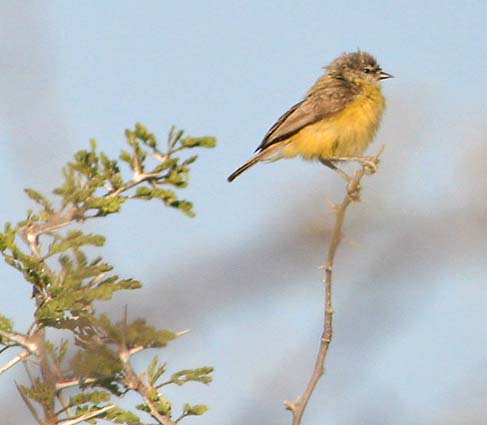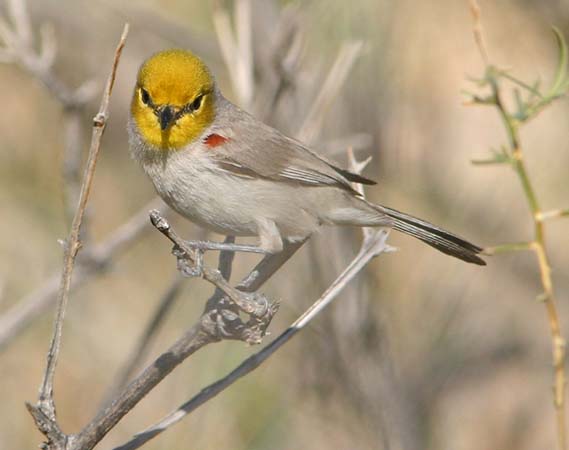| |
|
PENDULINE
TITS Remizidae
|
- 10 species worldwide
- DR personal total: 4 species (40%), 2
photos
|
|
 Penduline Tits are a small family of tiny
passerines found mostly in Eurasia and Africa, with a single example in
the New World. They are arboreal and insectivorous, like this Southern
Penduline-Tit (left) of southern Africa. They are generally
found in pairs or small groups. Habitat preferences include open
woodlands in Eurasian species, but also thornscrub in Africa and
southwestern North America. Penduline Tits are a small family of tiny
passerines found mostly in Eurasia and Africa, with a single example in
the New World. They are arboreal and insectivorous, like this Southern
Penduline-Tit (left) of southern Africa. They are generally
found in pairs or small groups. Habitat preferences include open
woodlands in Eurasian species, but also thornscrub in Africa and
southwestern North America.
Jønsson & Fjeldså (2006) recognized 13
branches (="clades") of Sylvioidea passerines, and the penduline tits
are found in clade 2 next to the parids (tits & chickadees) and the
stenostirid 'flycatchers' that are not flycatchers at all (more on that
below). Although close to the parids, they form a very distinctive
group biochemically, and this supports their retention as a distinct
family (see also Sheldon & Gill 1996, Gill et al. 2005,
Alström et al. 2006).
|
|
 The only New World member of the Remizidae is
Verdin (right), a small gregarious
passerine of the American southwest mesquite scrub. Its sibilant calls
are constant under the hot sun in that habitat. The only New World member of the Remizidae is
Verdin (right), a small gregarious
passerine of the American southwest mesquite scrub. Its sibilant calls
are constant under the hot sun in that habitat.
Among the features shared by the Old World penduline
tits and Verdin is that they all build "basically similar pendent,
pouch-like nests made of felted vegetable down with an opening near the
top" (Cramp & Perrins 1993). Those occurring in warm climates are
resident, but those in eastern Asia do move south in winter.
As noted, the biochemical evidence suggests that the
closest relatives are the Tits & Chickadees (and this seems
logically apparent) but they are also related to the stenostirids, a
previously overlooked group of African & Asian passerines that have
flycatching behaviors and have been considered 'flycatchers' in the
past (see Beresford et al. 2005, who propose that the Stenostiridae be
accepted as its own family). The true relationships among these groups
are not well resolved (Jønsson & Fjeldså 2006) and
further research is needed.
The inclusion of the stenostirids was a huge surprise,
and not anticipated by earlier writers. Some, like Harrap & Quinn
(1995) lumped penduline-tits with the regular tits, having been
confused by Sibley & Monroe's (1990) proposal that the remizids
were close to gnatcatchers. Harrap & Quinn also mistakenly placed
the African tit-hylia Pholidornis rushiae in this group, but
molecular research has shown that the tit-hylia is not closely related
at all (e.g., Sefe et al. 2003). Both Green Hylia and Tit-Hylia are
placed in Cettiidae
(Alström et al. 2006)
|
|
As it now stands, the Remizidae is composed of Verdin,
Eurasian Penduline-Tit in the genus Remiz, seven species of
Penduline-Tit in the genus Anthoscopus, and (tentatively)
Fire-capped Tit Dephalopyrus flammiceps of the Himalayas. It
will be interesting to see how this all shakes out over time as more
research is published. For now, the Penduline Tits are a group of very
tiny birds scattered in open or scrubby woodlands around the globe.
|
|
Photos: The Southern
Penduline Tit Anthoscopus minutus was in Etosha
National Park, Namibia, on 19 July 2005. The male Verdin
Auriparus flaviceps was in
Anza-Borrego State Park, California, on 13 Apr 2006. All photos © 2007 Don Roberson; all rights
reserved.
Family Book: Rating 
Harrap, Simon, and David Quinn. 1995. Chickadees,
Tits, Nuthatches & Treecreepers. Princeton Univ. Press,
Princeton, N. J.
This is a pleasant and solid addition to the family
books in the Princeton series. The plates appear separately in the
front. I found the artwork rather good in a "field guide" style
(without much background) opposite summary pages which include small
maps. The maps I looked at were quite good (e.g., they and the text
covered isolated populations of Mountain Chickadee in California, an
unexpected bit of accuracy I've come to not expect in such family
tomes). Distinct races are nicely covered, and they did well with the
variation in my local chickadee, the Chestnut-backed. The text cover
identification, habitat, breeding biology (very summarized),
relationships, and detailed plumage descriptions, plus references which
(in contrast to other similar efforts) look reasonably extensive. I
don't personally see the need for the detailed plumage descriptions
since no book like this can hope to cover the complete range of
variation, and they are very tedious to read, but it is the "style" of
these family books. There are some helpful extra maps and sketches of
plumage details scattered in the text.
I was a bit put off by the use of Sibley & Monroe
(1990) family taxonomy (since subject to criticism) and the unnecessary
"lumping" of the penduline tits with the "true" tits. [And in 1995,
they were also obviously unaware of the 21st century research that
would show Pseudopodoces "ground-jay" would prove to be a
tit.] It is the quality of the text that prompts me to give this a
"four-star" rating, just about as high of a rating that I'll give to
this type of family book.
This family will be covered by the Handbook of the
Birds of the World series in Vol. 12, due out in fall 2007.
Literature cited:
Alström P., P.G.P. Ericson, U. Olsson, and P.
Sundberg. 2006. Phylogeny and classification of the avian superfamily
Sylvoidea. Molecular Phylogenetics & Evolution 38: 381-397.
Beresford, P., F.K. Barker, P.G. Ryan, and T.M. Crowe.
2005. African endemics span the tree of songbird (Passeri): molecular
systematics of several evolutionary 'enigmas.' Proc. Royal Soc. London
B. 272: 849-858.
Cramp, S., and Perrins, C.M., eds. 1993. Handbook of
Europe, the Middle East and North Africa: the Birds of the Western
Palearctic. Vol. VII. Oxford Univ. Press, Oxford.
Gill, F.B., B. Slikas, and F.H. Sheldon. 2005.
Phylogeny of titmice (Paridae): II. Species relationships based on
sequences of the mitochondrial cytochrome-b gene. Auk 122:
121-142.
Jønsson, K.A., and J. Fjeldså. 2006. A
phylogenetic supertree of oscine passerine birds. Zoologica Scripta 35:
149-186.
Sefe, K.M., R.B. Payne, and M.D. Sorenson. 2003.
Phylogenetic relationships of AFrican sunbird-like warblers: Moho (Hypergerus
atriceps), Green Hylia (Hylia prasina) and Tit-hylia (Pholidornis
rushiae). Ostrich 74: 8-17.
Sheldon, F.H, and F.B. Gill. 1996. A reconsideration
of songbird phylogeny, with emphasis on the evolution of titmice and
their sylvioid relatives. Syst. Biol. 45: 473-495.
Sibley, C.G., and B.L. Monroe, Jr. 1990. Distribution
and Taxonomy of Birds of the World. Yale Univ. Press, New Haven, CT.
|
|
|

 Penduline Tits are a small family of tiny
passerines found mostly in Eurasia and Africa, with a single example in
the New World. They are arboreal and insectivorous, like this Southern
Penduline-Tit (left) of southern Africa. They are generally
found in pairs or small groups. Habitat preferences include open
woodlands in Eurasian species, but also thornscrub in Africa and
southwestern North America.
Penduline Tits are a small family of tiny
passerines found mostly in Eurasia and Africa, with a single example in
the New World. They are arboreal and insectivorous, like this Southern
Penduline-Tit (left) of southern Africa. They are generally
found in pairs or small groups. Habitat preferences include open
woodlands in Eurasian species, but also thornscrub in Africa and
southwestern North America.  The only New World member of the Remizidae is
Verdin (right), a small gregarious
passerine of the American southwest mesquite scrub. Its sibilant calls
are constant under the hot sun in that habitat.
The only New World member of the Remizidae is
Verdin (right), a small gregarious
passerine of the American southwest mesquite scrub. Its sibilant calls
are constant under the hot sun in that habitat.